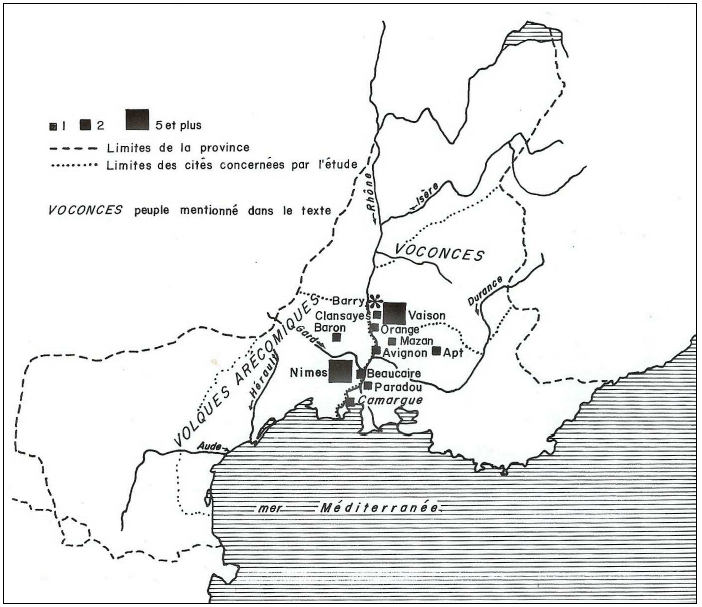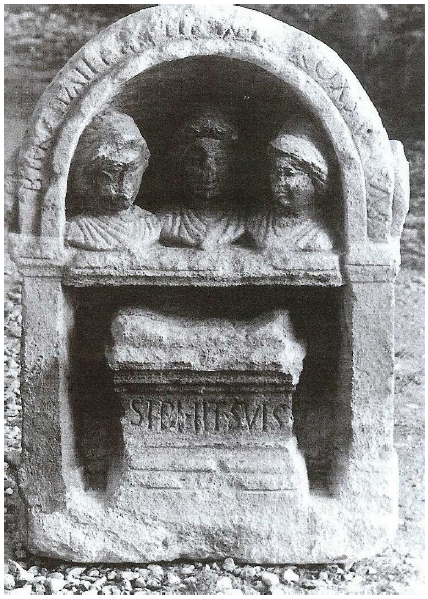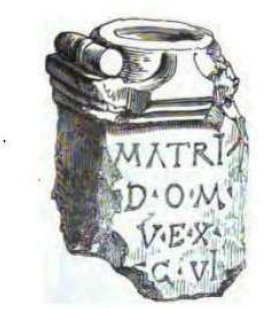D) The Proxsumae and the Domesticae
In the south of Gaul, thirty-nine inscriptions are dedicated to goddesses called Prox(s)umae, whose origin and essence remain somewhat obscure and mysterious, for they do not seem to be known in Classical religion, although their name is undeniably Latin. It is related to the Latin proximus, proxumus, which means ‘the ones who are the closest, the nearest, the most intimate (to somebody)’, hence the translation of their name by Paul-Marie Duval as ‘The Very Close Ones’, by André Buisson as ‘The Closest Ones’ and by Anwyl as ‘Kinswomen’.528
Their cult seems to have been strictly limited geographically to the lower Rhône valley, on the right and left banks of the Rhône, which is quite unusual (fig. 25). The inscriptions to them were discovered in Clansayes, near Montélimar (Drôme: 1), Barry (Vaucluse: 1), Vaison-la-Romaine (Vaucluse: 6), Orange (Vaucluse: 2), Mazan near Carpentras (Vaucluse: 2), Apt (Vaucluse: 1), Avignon (Vaucluse: 1), Baron (or Uzès?, Gard: 1), Nîmes (Gard: 21), Beaucaire (Gard: 1), Le Paradou (Bouches-du-Rhône: 1) and in Camargue, near Auricet (Bouches-du-Rhône: 1).529

Unlike the Junones, the Fatae, the Campestres or the Nymphs, the Prox(s)umes are never associated with the term Matres, Matrae, Matronae or with a Celtic divine title in the dedications. They are always venerated alone and interestingly twenty-one out of the thirty-nine dedications are offered by women, such as in this inscription from Nîmes: Laliae Primulae Proxsumis suis v.s.[l.m.],‘To her Proxsumae, Lalia Primula willingly and deservedly fulfilled her vow’.530 This shows that women had a very strong bond with those female deities, who were certainly protectresses of women in their everyday and family life. It is also noticeable in the inscriptions that the dedicators generally mark their close attachment to the Proxsumae by the use of the possessive adjective suus, dat. suis, ‘his’, ‘her’, ‘which belongs to him or her’. This has led scholars to think that the Proxsumae were probably spirits of the grandparents or protective genii guarding the individual, the family and the household, having thus a pronounced domestic and private dimension.531 At the end of the 19th c., specialists thought they were ‘topical or local’ deities, specifically related to the tribe of the Volcae Arecomici, but 20th-21st-century archaeological discoveries have proved that the cult was extended to the Rhône valley and to other peoples, such as the Libicii (?), the Cavari, the Nearchi (?), the Tricastini, the Albici, the Memini, the Vocontii and the Volcae.532 The fact that dedications were often discovered in the context of ancient habitats may evidence the domestic character of the Proxsumae.533 Moreover, Buisson points out that many of the votive altars are of very small size (around 20-cm high and 15-cm wide), which made them very easy to carry.534 It emphasizes the personal aspect and the intimate link with those deities. Interestingly, the possessive adjective is also used in relation to the Matres, suis Matribus, ‘to his/her own Mothers’, which establishes a link between them and the Proxsumae.535 Instances are found in inscriptions from Andernach: Matribus suis Similius Miles ex casse germanicap(ia) f(idelis) D(omitiana) pler(omate) Cresimi vsllm,536 from Berkum (Germany): Matribus suis Candidus et Paterna vslm,537 from Hadrian’s Wall (Drumburgh to Bowness-on-Solway, Cumbria): Matribus suis milite[s…], ‘To their own Mother Goddesses the soldiers […]’538 and from York (North Yorkshire): [M]atribus suis Marcus Rustius v(otum) s(olvit) l(aetus) Massa l(ibens) m(erito), ‘To his own Mother Goddesses Marcus Rustius Massa gladly, willingly, and deservedly fulfilled his vow’.539
Four of the dedications come with images of Classical type. The altar discovered in Vaison-la-Romaine (Vaucluse) has the depiction of a single goddess standing on a pedestal, wearing a classical tunic and short hair, and holding fruit, a cup or a patera* in her two hands. The inscription above reads: Proxsumis, Potita, C(…) Codonis f(ilia), v(otum) s(olvit) l(ibens) m(erito), ‘To the Proxsumae, Potita, daughter of C(aius) Codonius, paid her vow willingly and deservedly’.540 The Proxsumae are also represented as a group of two goddesses on the altar from Clansayes (Drôme), which shows a very damaged and rough engraving of two busts of goddesses and bears the following dedication: Proxsum[is] suis Baebia Eroe [s(olvit)] m(erito), ‘To her Proxsumae, Baebia Eroe paid her vow deservedly’.541 Finally, three busts of goddesses appear on the monument found in Barry, near Saint-Paul-Trois-Châteaux (Vaucluse),542 bearing the inscription Beratia E. P[…]I I [P]roxsumas Sibi et Suis, ‘Beratia (prays or implores) the Proxsumae for herself and her relatives’, and on the altar discovered in Nîmes (Gard), bearing the dedication Prox(umis) Bituka v.s.l.m., ‘To the Proxsumae, Bituka paid her vow willingly and deservedly’.543 On these two monuments, the Proxsumae are represented as a trio of goddesses, which relate them to the various iconographical figurations of the Matres and Matronae, who are generally represented as three in number (fig. 26).

Moreover, although the Proxsumae have a Latin name, it seems that they were originally Celtic deities, for a surprising great number of the dedicators and their fathers have typical Celtic names, such as Sennius,544 Attia,545 Vrassia,546 Bituka,547 Aviulla and her father Atilius,548 and Codonius.549As regards the names Lucceius,550 Verus,551 Seneca,552 Potita, the feminine version of Potitus,553 Laliae, possibly the feminine version of Lalus,554 and Baebia, the feminine version of Baevius,555 their Celticity is doubtful. Therefore, the Proxsumae, being three in number, protecting women and being invoked by people of Celtic stock have many similarities to the Matres, whom they may have replaced in this particular area of Gaul (the Rhône Valley). On account of their geographical distribution, the Gallo-Roman cult of the Proxsumae is certainly of indigenous origin and, even though their Gaulish name never appears in the inscriptions, it can be assumed that that their name was translated from a Gaulish theonym, which Lambert reconstitutes as *nessama- (*neθθama-).556
The Proxsumae are thus very similar to the Domesticae, who are, as their Latin title indicates ‘The Ones of the Household’ or ‘Relative to the Family’.557 They are for instance honoured in inscriptions from Bonn: Iulia Teratia Domisticis v.s.l.m.,558 and Niederbronn (Germany) Dom[…].559 The Domesticae are an epithet of the Matres in various dedications from Britain, such as in Stanwix (Cumbria): Matribu[s D]omesticis [s]uis Asin[ius] S[e]nili[s] vsl[m], ‘To his own Mother Goddesses of the household Asinius Senilis willingly and deservedly fulfilled his vow’,560 in Burgh-by-Sands, near Hadrian’s Wall (Cumbria): Matri(bus) Dom(esticis) uex(illation) [l]eg(ionis) VI [V(ictricis)] P(iae) F(idelis), ‘To the Mother Goddesses of the Household a detachment of the Sixth Legion Victrix Pia Fidelis (set this up)’ (fig. 27),561 in York (Yorkshire): G(aius) Iuliu(s) Crescens Matribus Domesticis vslm, ‘Gaius Julius Crescens to the Mother Goddesses of the household willingly and deservedly fulfilled his vow’,562 and in Catterick (North Yorkshire): Matribus Domesti(cis) Iul(ius) Victor pro se et suis vsllm.563 Three other examples, dating from the end of the 2nd c. AD to the beginning of the 3rd c. AD, are found in Bonn (Germany): Iul(ius) Qu[…] Ma(tribus) Do[mesticis] ; Matribu[s] Domest[i]ci[s] ; [Matribus Do]mesticis […]uibus […]cdonib […]flaus [apol]lodo[rus et] M. avr si.564 The Germanic Mother Goddesses Aufaniae are also called Domesticae in two dedications from Bonn (Germany): Matr[onis] Aufan[iabus] Dom[…] ; Matribus sive Matronis Aufanabus Domesticis M. Clodius Marcellinus Mles Leg I M v.s.l. 565 As shown by the frequent epithet Domesticae, it is clear that the Matres must have had a role of protectresses of the household and must have been worshipped in familial and personal contexts.
